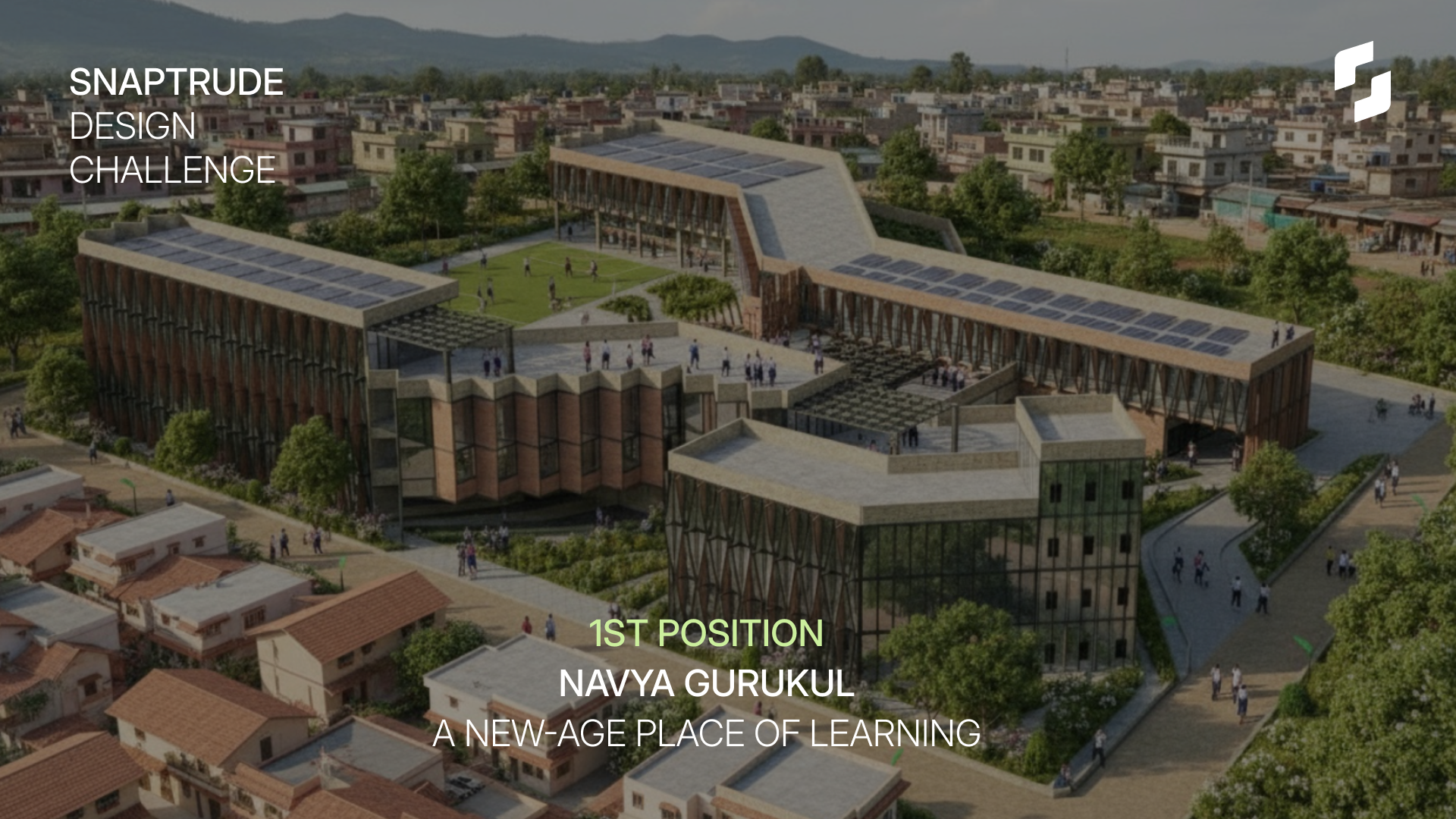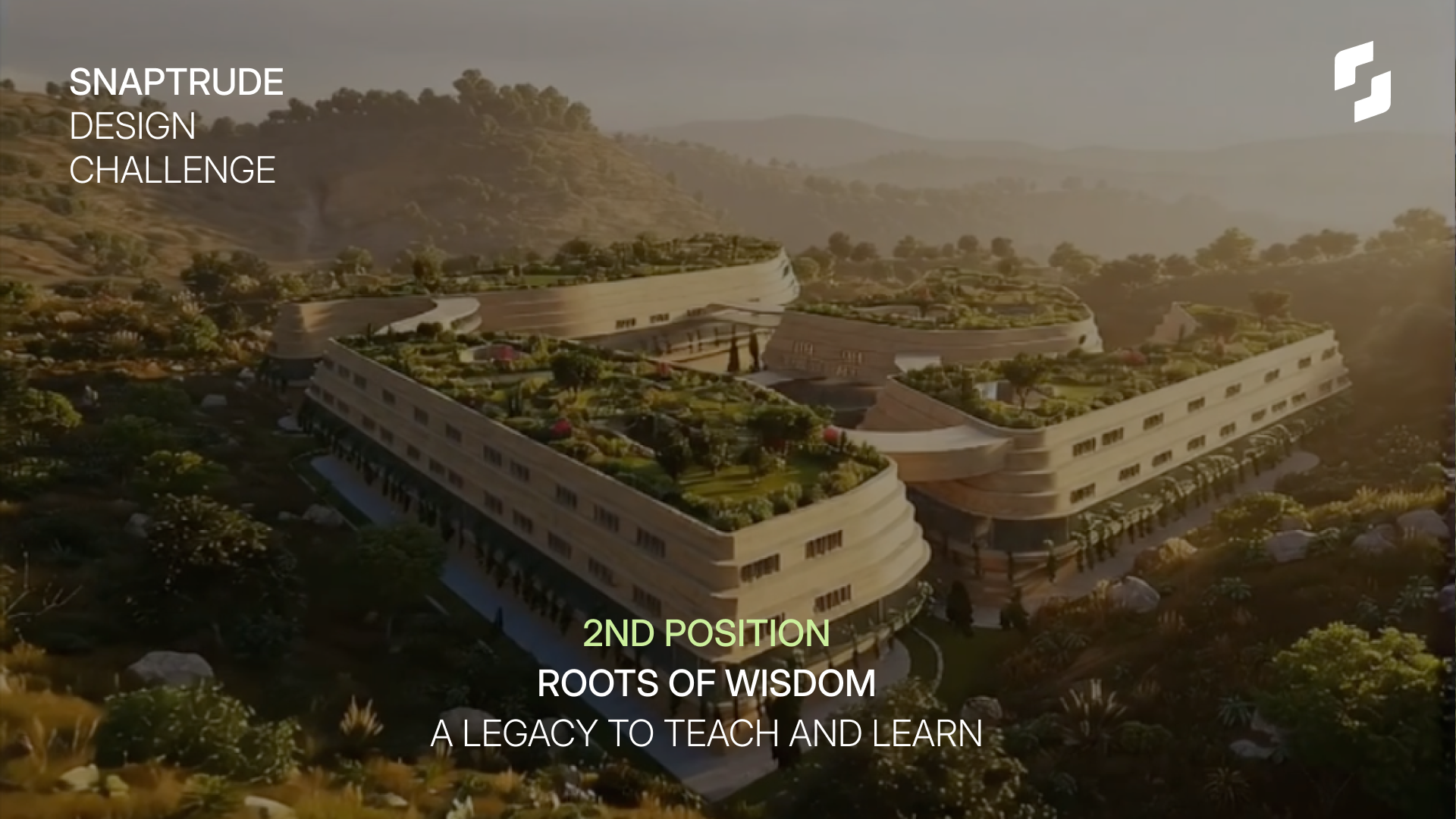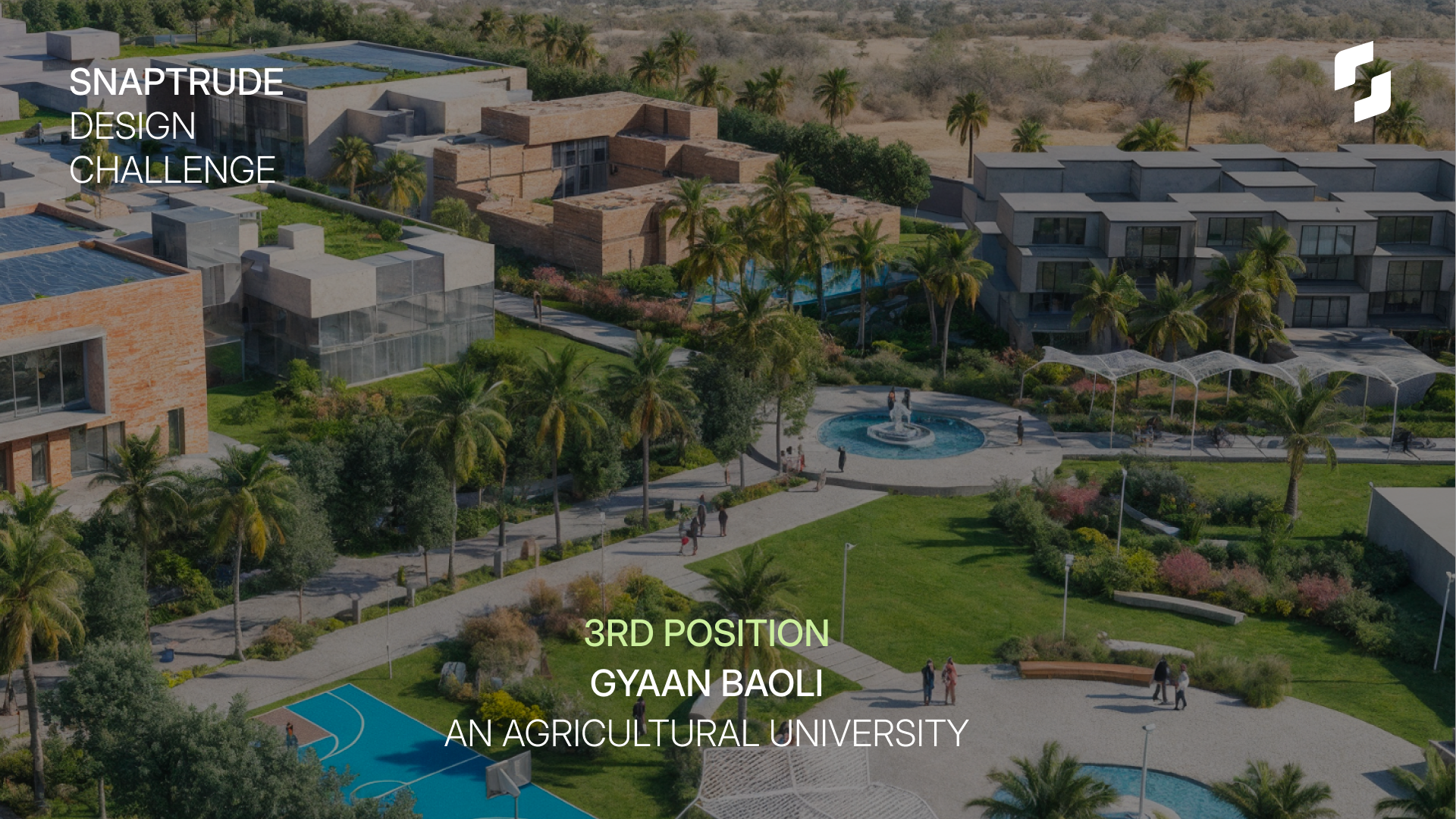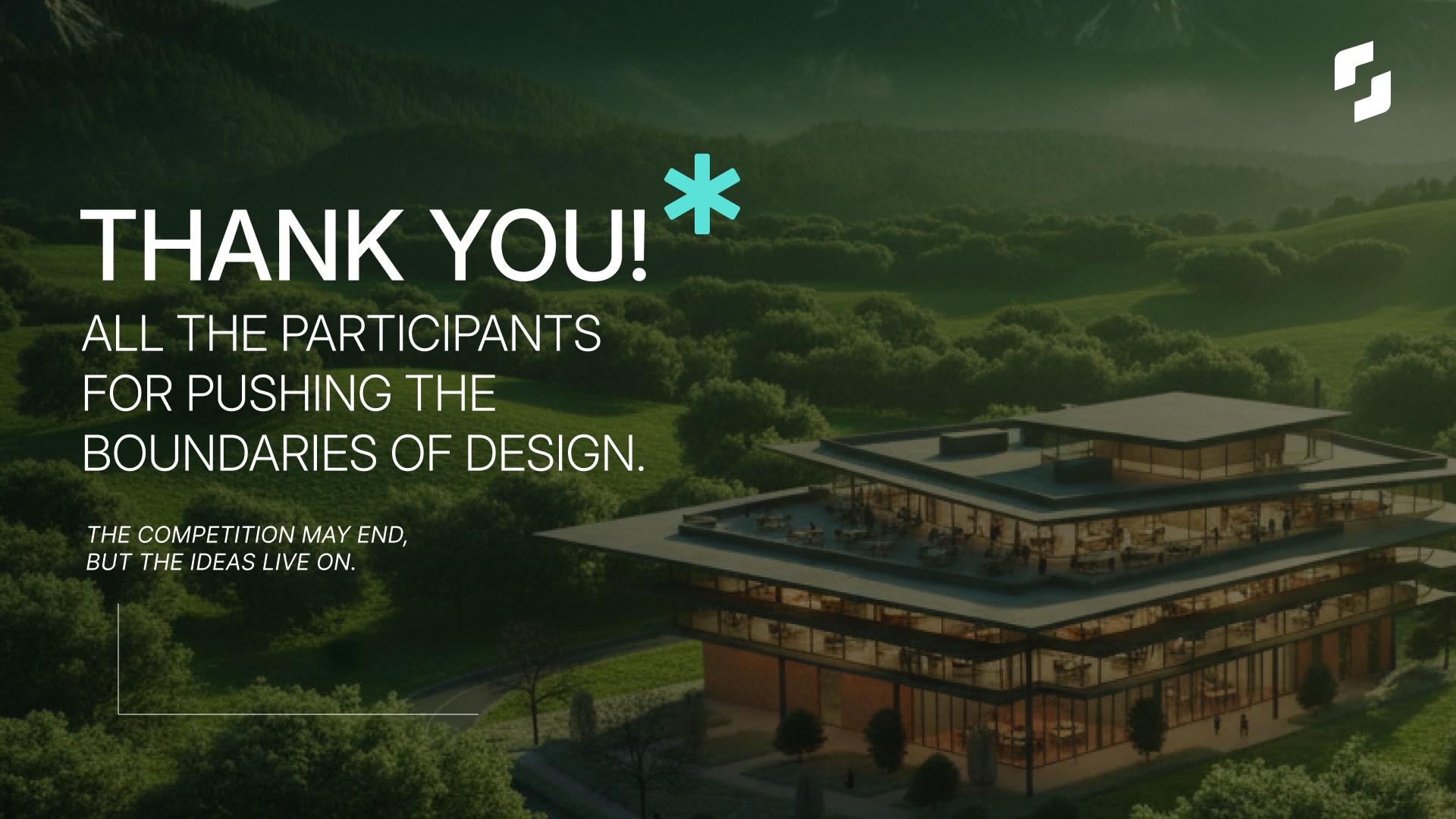Winners Announced for the Snaptrude Design Challenge 2025

Snaptrude is delighted to announce the results of the Snaptrude Design Challenge 2025 (SDC 2025), a global competition inviting architects, students, and professionals to imagine learning environments for the future.
This year’s theme, “Design for the needs of 2035,” asked participants to create spaces that rethink how we learn, live, and connect, through sustainability, inclusivity, and digital innovation.
Entries poured in from across the world, exploring new models of education that merge climate awareness, cultural identity, and technology. After careful evaluation, the jury selected projects that demonstrated clarity of vision, contextual intelligence, and a balance of creativity with constructability.
First Place: Navya Gurukul
By: Muskaan

Location: Patan, Gujarat
Set beside Pitamber Lake in the historic city of Patan, Navya Gurukul reimagines the idea of a school as a bridge between heritage and the future. The design celebrates craft, culture, and climate while creating a living ecosystem of learning. Drawing from the region’s stepwell architecture and artisanal traditions, it builds an educational environment that feels timeless yet forward-looking.
Jury Comments:
- Connects heritage with a future learning program.
- Deeply rooted in local culture, climate, and materials.
- Turns the school into a living, sustainable ecosystem.
- Strong community integration through shared public spaces.
- Beautiful, buildable, and clearly communicated design vision.
Navya Gurukul stood out for its poetic yet practical integration of sustainability, flexibility, and cultural identity, a school that learns from its past while preparing for the future.
Second Place: Roots of Wisdom
By: The Bee Hive Studio

Location: Pushkar, Rajasthan
Roots of Wisdom draws from the spirit of ancient Indian learning centers, crafting a calm, reflective campus deeply connected to its desert landscape. Courtyards, shaded walkways, and voids shape spaces that breathe and evolve with climate and time.
Jury Comments:
- Creates a sense of stillness and belonging through spatial rhythm.
- Uses courtyards and voids as living, breathing classrooms.
- Strong bioclimatic response using local materials and passive cooling.
- A poetic interpretation of tradition meeting modern learning.
- Demonstrates how restraint can be a powerful design gesture.
The project was praised for its quiet strength, a design that embraces slowness, nature, and community to nurture thoughtful learning.
Third Place: Gyaan Baoli
By: Two Plus Two Studio

Location: Chittorgarh, Rajasthan
In Gyaan Baoli, an agricultural university becomes a self-sustaining ecosystem where technology, ecology, and architecture work together. The design integrates AI-driven irrigation, hydroponics, and vertical farming with passive cooling and indigenous materials, rooted in Rajasthan’s desert context.
Jury Comments:
- Integrates farming, learning, and sustainability seamlessly.
- Climate-sensitive design rooted in Rajasthan’s material culture.
- Smart use of AI and data-driven planning for resilience.
- Creates a “living campus” where landscape and architecture co-evolve.
- A strong model for future-ready agricultural education.
By combining data-driven design with vernacular wisdom, Gyaan Baoli demonstrates how technology can enhance, not replace, the intelligence of place.
Sustainability Award: Syracuse Resilience Project
By: Sara Berg and Curtis Idol

Location: Syracuse, New York
The Syracuse Resilience Project envisions a campus as a “Living Learning Organism”, an ecosystem where architecture adapts, produces energy, and responds to climate. Integrating renewable systems, AI, and real-time data, it positions sustainability as both infrastructure and pedagogy.
Jury Comments:
- Integrates renewable energy, AI, and data systems into learning.
- Designs for extreme climate adaptability and community resilience.
- Sets a benchmark for sustainable, technology-led education.
The project was recognized for redefining resilience, not just as endurance, but as a capacity to evolve.
Community Impact Award: OA Academy
By: Opey Theophilus

Location: Accra, Ghana
OA Academy envisions a solar-guided circular campus where light, water, and greenery converge to form a holistic, future-ready learning environment. The design draws from African spatial traditions, creating a vibrant and inclusive setting for collective growth.
Jury Comments:
- Centers people and inclusivity through a radial, walkable masterplan.
- Uses light and water as symbols of unity and renewal.
- Merges cultural identity with environmental intelligence.
- A strong example of architecture as social infrastructure.
By placing community and culture at its core, OA Academy shows how educational architecture can be both timeless and transformative.
Reflections on SDC 2025
Across all winning entries, the jury noted clear trends shaping the design for the needs of 2035:
- Architecture as a living system: adaptable, responsive, and inclusive.
- A renewed interest in context, climate, and vernacular wisdom.
- Seamless integration of technology to support, not overshadow, design.
- A shift from static campuses to evolving ecosystems of learning.
Acknowledgment

Snaptrude thanks all participants for their creativity, rigor, and imagination. The 2025 Design Challenge showcased how global designers are redefining the relationship between architecture, learning, and the planet.
We congratulate Navya Gurukul, Roots of Wisdom, Gyaan Baoli, Syracuse Resilience Project, and OA Academy submissions for their visionary contributions and for embodying the spirit of future-ready design.


